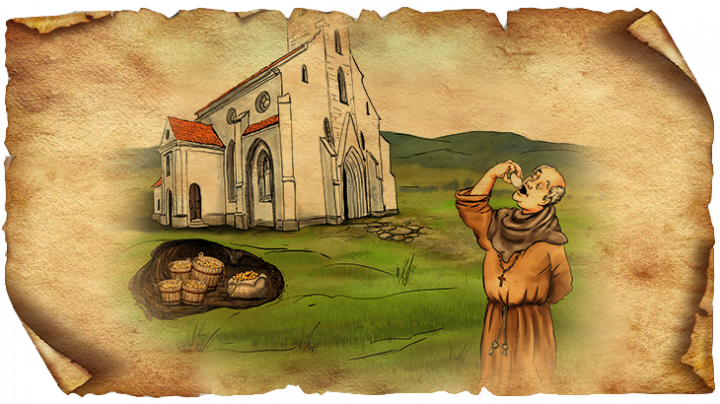The Legend of Lőrinc Friar - Reghin

Szászrégen / Reghin, on the side of the river Maros / Mures, is the second largest settlement of the county after Marosvásárhely / Târgu Mureș, the seat of the county. The oldest and most important attraction is the Lutheran Church, to which several beliefs are attached.
According to a legend, the church was originally built by a friar called Lőrinc - he was rich and thought that after completing the construction of the church, he would remain so wealthy that he could live without problems until end of life. However, the construction works consumed his reserves so that only one egg was left from his huge wealth - Lőrinc ate it and died immediately. It is a fact that on the southwest side of the church, on the wall of the St. Lawrence Chapel there is a torso that is supposed to represent St. Lawrence.
According to another tradition, a large amount of treasure is hidden under one of the carved stone steps of the church, in the event that the church was destroyed: it would be possible to rebuild the house of God.
The church of the city, presumably founded in King St. Ladislaus's ruling time, was actually built in the 13th century. The symbol of Szászrégen: He weathered the storms of centuries, destroyed in fire in 1708 and 1848, then the ancient Lutheran church was rebuilt by modifying the original building. As for the artistic and architectural curiosities, the evangelical church retained an early Gothic window with reliefs of human heads that probably depict Tamás Bánffy the first architect and his wife. In addition, architectural rarities include the cabin in the shrine and the coat of arms above the sacristy door, which was used as a coat of arms of the city for a long time.
Not only this church is one of the most important sights in Szászrégen, although it is undoubtedly the best known. The former independent settlement, the Reformed Church of Hungary, was also built in the 13th century, and the Roman Catholic Church was built in 1781. The sculpture park here commemorates the great personalities of the Hungarian history and culture.
In 1744, a Greek Catholic church was built in Magyarrégen – it is used by the Orthodox Church today, as well as the Greek Catholic Church of Szászrégen, which was completed in 1813.
Until 1848, its streets, like those of other medieval Transylvanian cities, were narrow, winding. That year, however, the image of the city was "retailored". In the past, a famous ethnographic museum has been operating since the 1960s, but there is a great tradition of instrument making. Szászrégenis also called the city of violins: the Hora instrument factory was founded in 1951 by Roman Boianciuc instrument maker.
If you visit Szászrégen, you can order local specialties - even eggs - in the pretty restaurants of the main square, as you can be sure that it will not happen the same as to the legendary Lőrinc friar.
According to a legend, the church was originally built by a friar called Lőrinc - he was rich and thought that after completing the construction of the church, he would remain so wealthy that he could live without problems until end of life. However, the construction works consumed his reserves so that only one egg was left from his huge wealth - Lőrinc ate it and died immediately. It is a fact that on the southwest side of the church, on the wall of the St. Lawrence Chapel there is a torso that is supposed to represent St. Lawrence.
According to another tradition, a large amount of treasure is hidden under one of the carved stone steps of the church, in the event that the church was destroyed: it would be possible to rebuild the house of God.
The church of the city, presumably founded in King St. Ladislaus's ruling time, was actually built in the 13th century. The symbol of Szászrégen: He weathered the storms of centuries, destroyed in fire in 1708 and 1848, then the ancient Lutheran church was rebuilt by modifying the original building. As for the artistic and architectural curiosities, the evangelical church retained an early Gothic window with reliefs of human heads that probably depict Tamás Bánffy the first architect and his wife. In addition, architectural rarities include the cabin in the shrine and the coat of arms above the sacristy door, which was used as a coat of arms of the city for a long time.
Not only this church is one of the most important sights in Szászrégen, although it is undoubtedly the best known. The former independent settlement, the Reformed Church of Hungary, was also built in the 13th century, and the Roman Catholic Church was built in 1781. The sculpture park here commemorates the great personalities of the Hungarian history and culture.
In 1744, a Greek Catholic church was built in Magyarrégen – it is used by the Orthodox Church today, as well as the Greek Catholic Church of Szászrégen, which was completed in 1813.
Until 1848, its streets, like those of other medieval Transylvanian cities, were narrow, winding. That year, however, the image of the city was "retailored". In the past, a famous ethnographic museum has been operating since the 1960s, but there is a great tradition of instrument making. Szászrégenis also called the city of violins: the Hora instrument factory was founded in 1951 by Roman Boianciuc instrument maker.
If you visit Szászrégen, you can order local specialties - even eggs - in the pretty restaurants of the main square, as you can be sure that it will not happen the same as to the legendary Lőrinc friar.
